
Read through any archive of science fiction movies, and you quickly realize that the merger of pop culture and science dates as far back as the dawn of cinema in the early 1920s. Even more surprising than the enduring prevalence of science in film is that the relationship between film directors, scribes and the science advisors that have influenced their works is equally as rich and timeless. Lab Coats in Hollywood: Science, Scientists, and Cinema (2011, MIT Press), one of the most in-depth books on the intersection of science and Hollywood to date, serves as the backdrop for recounting the history of science and technology in film, how it influenced real-world research and the scientists that contributed their ideas to improve the cinematic realism of science and scientists. For a full ScriptPhD.com review and in-depth extended discussion of science advising in the film industry, please click the “continue reading” cut.
Written by David A. Kirby, Lecturer in Science Communication Studies at the Centre for History of Science, Technology and Medicine at the University of Manchester, England, Lab Coats offers a surprising, detailed analysis of the symbiotic—if sometimes contentious—partnership between filmmakers and scientists. This includes the wide-ranging services science advisors can be asked to provide to members of a film’s production staff, how these ideas are subsequently incorporated into the film, and why the depiction of scientists in film carries such enormous real-world consequences. Thorough, detailed, and honest, Lab Coats in Hollywood is an exhaustive tome of the history of scientists’ impact on cinema and storytelling. It’s also an essential and realistic road map of the challenges that scientists, engineers and other technical advisors might face as they seriously pursue science advising to the film industry as a career.
The essential questions that Lab Coats in Hollywood addresses are these—is it worth it to hire a science advisor for a movie production? Is it worth it for the scientist to be an advisor? The book’s purposefully vague conclusion is that it depends solely on how the scientist can film’s storyline and visual effects. Kirby wisely writes with an objective tone here because the topic is open to a considerable amount of debate among the scientists and filmmakers profiled in the book. Sometimes a scientist is so key to a film’s development, he or she becomes an indispensible part of the day-to-day production. A good example of this is Jack Horner, paleontologist at the Museum of the Rockies in Bozeman, MT, and technical science advisor to Steven Spielberg in Jurassic Park and both of its sequels. Horner, who drew from his own research on the link between dinosaurs and birds for a more realistic depiction of the film’s contentious science, helped filmmakers construct visuals, write dialogue, character reactions, animal behaviors, and map out entire scenes. J. Marvin Herndon, a geophysicist at the Transdyne Corporation, approached the director of the disaster film The Core when he learned the plot was going to be based on his controversial hypothesis about a giant uranium ball in the center of the Earth. Herndon’s ideas were fully incorporated into the film’s plot, while Herndon rode the wave of publicity from the film to publish his research in a PNAS paper. The gold standard of science input, however, were Stanley Kubrik’s multiple science and engineering advisors for 2001: A Space Odyssey, discussed in much further detail below.

Kirby hypothesizes that sometimes, a film’s poor reception might have been avoided with a science advisor. He provides the example of the Arnold Schwarzenegger futuristic sci-fi bomb The Sixth Day, which contained a ludicrously implausible use of human cloning in its main plot. While the film may have been destined for failure, Kirby posits that it only could have benefited from proper script vetting by a scientist. By contrast, the 1998 action adventure thriller Armageddon came under heavy expert criticism for its basic assertion that an asteroid “the size of Texas” could go undetected until eighteen days before impact. Director Michael Bay patently refused to take the advice of his advisor, NASA researcher Ivan Bakey, and admitted he was sacrificing science for plot, but Armageddon went on to be a huge box office hit regardless. Quite often, the presence of a science advisor is helpful, albeit unnecessary. One of the book’s more amusing anecdotes is about Dustin Hoffman’s hyper-obsessive shadowing of a scientist for the making of the pandemic thriller Outbreak (great guide to the movie’s science can be found here). Hoffman was preparing to play a virologist and wanted to infuse realism in all of his character’s reactions. Hoffman kept asking the scientist to document reactions in mundane situations that we all encounter—a traffic jam, for example—only to come to the shocking conclusion that the scientist was a real person just like everyone else.
Most of the time, including scientists in the filmmaking process is at the discretion of the studios because of the one immutable decree reiterated throughout the book: the story is king. When a writer, producer or director hires a science consultant, their expertise is utilized solely to facilitate, improve or augment story elements for the purposes of entertaining the audience. Because of this, one of the most difficult adjustments a science consultant may face is a secondary status on-set even though they may be a superstar in their own field. Some of the other less glamorous aspects of film consulting include heavy negotiations with unionized writers for script or storyline changes, long working hours, a delicate balance between side consulting work and a day job, and most importantly, an inconsistent (sometimes nonexistent) payment structure per project. I was notably thrilled to see Kirby mention the pros and cons of programs such as the National Science Foundation’s Creative Science Studio (a collaboration with USC’s school of the Cinematic Arts) and the National Academy of Science’s Science and Entertainment Exchange, which both provide on-demand scientific expertise to the Hollywood filmmaking community in the hope of increasing and promoting the realism of scientific portrayal in film. While valuable commodities to science communication, both programs have had the unfortunate effect of acclimating Hollywood studios to expect high-level scientific consulting for free.
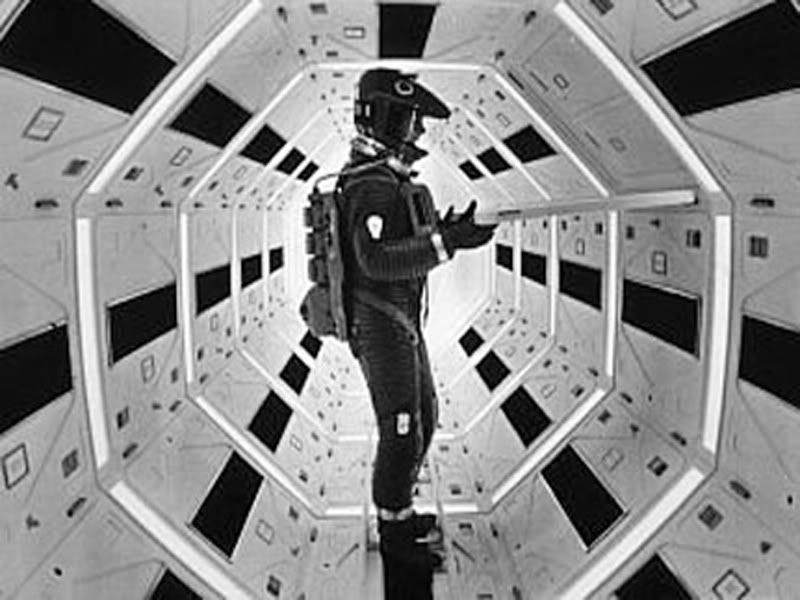
1968’s 2001: A Space Odyssey is widely considered by popular consensus to be the greatest sci-fi movie ever made, and certainly the most influential. As such, Kirby devotes an entire chapter to detailing the film’s production and integration of science. Director Stanley Kubrik took painstaking detail in scientific accuracy to explore complex ideas about the relationship between humanity and technology, hiring a range of advisors from anthropologists, aeronautical engineers, statisticians, and nuclear physicists for various stages of production. Statistician I. J. Good provided advice on supercomputers, aerospace Harry Lange provided production design, while NASA space scientist Frederick Ordway lent over three years of his time to develop the space technology used in the film. In doing so, Kubrik’s staff consulted with over sixty-five different private companies, government agencies, university groups and research institutions. So real was the space technology in 2001 that moon landing hoax supporters have claimed the real moon landing by United States astronauts, taking place in 1969, was taped on the same sets. Not every science-based film has used science input as meticulously or thoroughly since, but Kubrik’s influence on the film industry’s fascination with science and technology has been an undeniable legacy.
One of the real treats of Lab Coats in Hollywood is the exploration of the two-way relationship between scientists and filmmakers, and how film in turn influences the course of science, as we discuss in more detail below. Between film case studies, critiques and interviews with past science advisors are interstitial vignettes of ways scientists have shaped films we know and love. Even the animated feature Finding Nemo had an oceanography advisor to get the marine biology correct. The seminal moment of the most recent Star Trek installation was due to a piece of off-handed scientific advice from an astronomer. The cloning science of Jurassic Park, so thoroughly researched and pieced together by director Steven Spielberg and science advisor Jack Horner, was actually published in a top-notch journal days ahead of the movie’s premiere. Even in rare spots where the book drags a bit with highly technical analysis are cinematic backstories with details that readers will salivate over. (For example, there’s a very good reason all the kelp went missing from Finding Nemo between its cinematic and DVD releases.)
As the director of a creative scientific consulting company based in Los Angeles, one of the biggest questions I get asked on a regular basis is “What does a science advisor do, exactly?” Lab Coats in Hollywood does an excellent job of recounting stories and case studies of high-profile scientist consultants, all of whom contributed their creative talents to their respective films in different ways, what might be expected (and not expected) of scientists on set, and of giving different areas of expertise that are currently in demand in Hollywood. Kirby breaks down cinematic fact checking, the most frequent task scientists are hired to perform, into three areas within textbook science (known, proven facts that cannot be disputed, such as gravity): public science, something we all know and would think was ridiculous if filmmakers got wrong, expert science, facts that are known to specialists and scientific experts outside of the lay audience, and (most problematic) folk science, incorrect science that has nevertheless been accepted as true by the public. Filmmakers are most likely to alter or modify facts that they perceive as expert science to minimize repercussions at the box office.
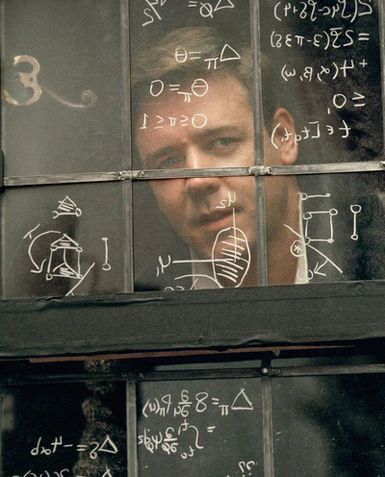
A science advisor is constantly navigating cinematic storytelling constraints and a filmmaker’s desire to utilize only the most visually appealing and interesting aspects of science (regardless of whether the context is always academically appropriate). Another broad area of high demand is in helping actors look and act like a real scientist on screen. Scientists have been hired to do everything from doctoring dialogue to add realism into an actor’s portrayal (the movie Contact and Jodie Foster’s depiction of Dr. Ellie Arroway is a good example of this), training actors in using equipment and pronouncing foreign-sounding jargon, replicating laboratory notebooks or chalkboard scribbles with the symbols and shorthand of science (such as in the mathematics film A Beautiful Mind), and to recreate the physical space of an authentic laboratory. Finally, the scientist’s expertise of the known is used to help construct plausible scenarios and storylines for the speculative, an area that requires the greatest degree of flexibility and compromise from the science advisor. Uncertainty, unexplored research and “what if” scenarios, the bane of every scientist’s existence, happen to be Hollywood’s favorite scenarios, because they allow the greatest creative freedom in storytelling and speculative conceptualization without being negated by a proven scientific impossibility. An entire chapter—the book’s finest—is devoted to two case studies, Deep Impact and The Hulk, where real science concepts (near-Earth asteroid impacts and genetic engineering, respectively) were researched and integrated into the stories that unfolded in the films. (Side note: if you are ever planning on being a science advisor read this section of the book very carefully).
In years past, consulting in films didn’t necessarily bring acclaim to scientists within their own research communities; indeed, Lab Coats recounts many instances where scientists were viewed as betraying science or undermining its seriousness with Hollywood frivolity, including many popular media figures such as Carl Sagan and Paul Ehrlich. Recently, however, consultants have come to be viewed as publicity investments both by studios that hire high-profile researchers for recognition value of their film’s science content and by institutes that benefit from branding and exposure. Science films from the last 10-15 years such as GATTACA, Outbreak, Armageddon, Contact, The Day After Tomorrow and a panoply of space-related flicks have attached big-name scientists as consultants (gene therapy pioneer French Anderson, epidemiologist David Morens, NASA director Ivan Bekey, SETI institute astronomers Seth Shostak and Jill Tartar and climatologist Michael Molitor, respectively). They also happened to revolve around the research salient to our modern era: genetic bioengineering, global infectious diseases, near-earth objects, global warming and (as always) exploring deep space. As such, a mutually beneficial marketing relationship has emerged between science advisors and studios that transcends the film itself resulting in funding and visibility to individual scientists, their research, and even institutes and research centers. The National Severe Storms Laboratory (NSSL) promoted themselves in two recent films, Twister and Dante’s Peak, using the films as a vehicle to promote their scientific work, to brand themselves as heroes underfunded by the government, and to temper public expectations about storm predictions. No institute has had a deeper relationship with Hollywood than NASA, extending back to the Star Trek television series, with intricate involvement and prominent logo display in the films Apollo 13, Armageddon, Mission to Mars, and Space Cowboys. Some critics have argued that this relationship played an integral role in helping NASA maintain a positive public profile after the devastating 1986 Challenger space shuttle disaster. The end result of the aforementioned promotion via cinematic integration can only benefit scientific innovation and public support.

Accurate and favorable portrayal of science content in modern cinema has an even bigger beneficiary than specific research institutes, and that is society itself. Fictional technology portrayed in film – termed a “diegetic prototype” – has often inspired or led directly to real-world application and development. Kirby offers the most impactful case of diegetic prototyping as the 1981 film Threshold, which portrayed the first successful implantation of a permanent artificial heart, a medical marvel that became reality only a year later. Robert Jarvik, inventor of the Jarvik-7 artificial heart used in the transplant, was also a key medical advisor for Threshold, and felt that his participation in the film could both facilitate technological realism and by doing so, help ease public fears about what was then considered a freak surgery, even engendering a ban in Great Britain. Of the many obstacles that expensive, ambitious, large-scale research faces, Kirby argues that skepticism or lack of enthusiasm from the public can be the most difficult to overcome, precisely because it feeds directly into essential political support that makes funding possible. A later example of film as an avenue for promotion of futuristic technology is Minority Report, set in the year 2054, and featuring realistic gestural interfacing technology and visual analytics software used to predict crime before it actually happens. Less than a decade later, technology and gadgets featured in the film have come to fruition in the form of multi-touch interfaces like the iPad and retina scanners, with others in development including insect robots (mimics of the film’s spider robots), facial recognition advertising billboards, crime prediction software and electronic paper. A much more recent example not featured in the book is the 2011 film Limitless, featuring a writer that is able to stimulate and access 100% of his brain at will by taking a nootropic drug. While the fictitious drug portrayed in the film is not yet a neurochemical reality, brain enhancement is a rising field of biomedical research, and may one day indeed yield a brain-boosting pill.
No other scientific feat has been a bigger beneficiary of diegetic prototyping than space travel, starting with 1929’s prophetic masterpiece Frau im Mond [Woman in the Moon], sponsored by the German Rocket Society and advised masterfully by Hermann Oberth, a pioneering German rocket research scientist. The first film to ever present the basics of rocket travel in cinema, and credited with the now-standard countdown to zero before launch in real life, Frau im Mond also featured a prototype of the liquid-fuel rocket and inspired a generation of physicists to contribute to the eventual realization of space travel. Destination Moon, a 1950 American sci-fi film about a privately financed trip to the Moon, was the first film produced in the United States to deal realistically with the prospect of space travel by utilizing the technical and screenplay input of notable science fiction author Robert A. Heinlein. Released seven years before the start of the USSR Sputnik program, Destination Moon set off a wave of iconic space films and television shows such as When Worlds Collide, Red Planet Mars, Conquest of Space and Star Trek in the midst of the 1950s and 1960s Cold War “space race” between the United States and Russia. What theoretical scientific feat will propel the next diegetic prototype? A mission to Mars? Space colonization? Anti-aging research? Advanced stem cell research? Time will only tell.
Ultimately, readers will enjoy Lab Coats in Hollywood for its engaging writing style, detailed exploration of the history of science in film and most of all, valuable advice from fellow scientists who transitioned from the lab to consulting on a movie set. Whether you are a sci-fi film buff or a research scientist aspiring to be a Hollywood consultant, you will find some aspect of this book fascinating. Especially given the rapid proliferation of science and technology content in movies (even those outside of the traditional sci-fi genre), and the input from the scientific community that it will surely necessitate, knowing the benefits and pitfalls of this increasingly in-demand career choice is as important as its significance in ensuring accurate portrayal of scientists to the general public.
~*ScriptPhD*~
***************
ScriptPhD.com covers science and technology in entertainment, media and advertising. Hire our consulting company for creative content development.
Subscribe to free email notifications of new posts on our home page.
]]>
I was recently watching Wall Street: Money Never Sleeps, the sequel to the Oscar-winning 1987 financial cautionary tale. In the middle of a movie that had nothing to do with science, the lead character started explaining the financial investment potential of a national research facility loosely based on the ultra-exclusive National Ignition Facility in Livermore, CA (which ScriptPhD.com was fortunate to visit and profile recently). The film did such an impressive job of explaining the laser technology being used in real life to harness endless quantities of energy from a molecular fusion reaction that it could have easily been lifted from a physics textbook. Translating, explaining and visually presenting complex science on film is not an easy task. It got us to thinking about some of the greatest science and technology moments of all time in film.
In no particular order, with the help of our readers and fans, here are ScriptPhD.com’s choices for the Top 10 gamechangers of science and/or technology cinematic content that was either revolutionary for its time, was smartly conceived and cinematically executed, or has bared relevance to later research advances.
Gattaca
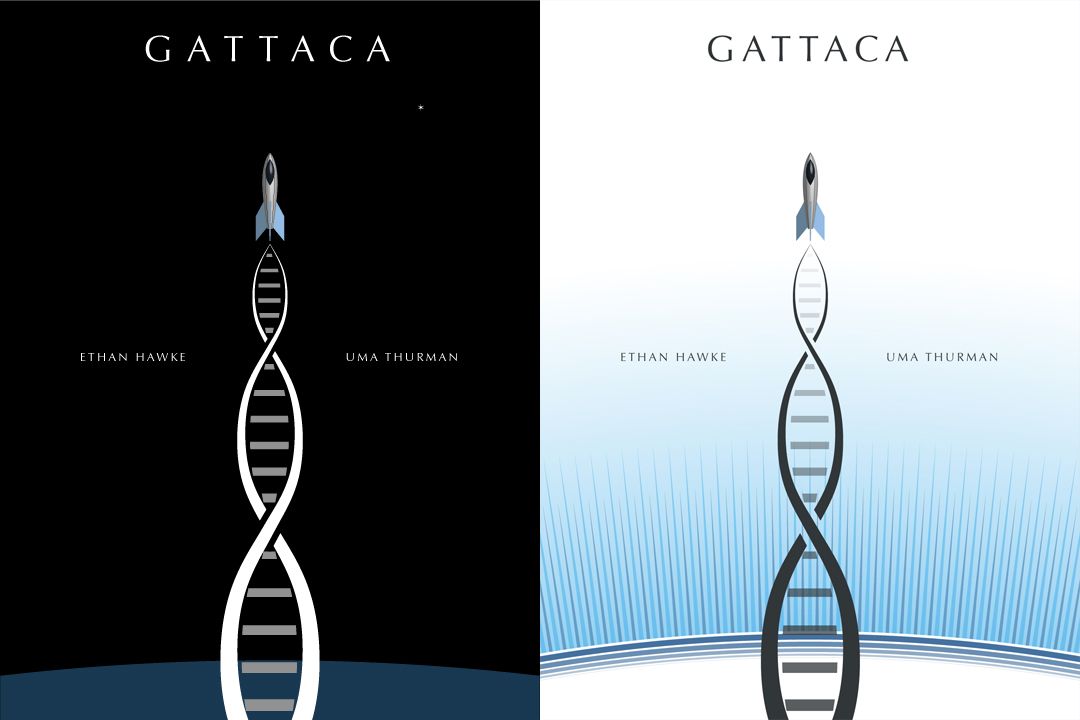
A trend-setter in genomics and bioinformatics, long before they were scientific staples, 1997 sci-fi masterpiece Gattaca has some of the most thoughtful, smart, introspective science of any film. To realize his life-long dream of space travel, genetically inferior Vincent Freeman (Ethan Hawke) assumes the DNA identity of Jerome Morrow (Jude Law), but becomes a suspect in the murder of the space program director. Not only is this the first (and only) movie to have a clever title composed solely of DNA sequence letters (G, A, T and C are the nucleotide bases that make up DNA), it was declared by molecular biologist Lee M. Silver as “a film that all geneticists should see if for no other reason than to understand the perception of our trade held by so many of the public-at-large.” In 1997, we were still 6 years away from the completion of the Human Genome Project. Post that feat of modern biotechnology, the ability to obtain ‘personal genomics’ disease profiles has led bioethicists to question who is to be entrusted with interpreting personal DNA information, and the United States Congress to pass the Genetic Information Non-Discrimination Act. Could we find ourselves in a world that judges the genetically perfect as ‘valids’ and anyone with minor flaws (and what constitutes a flaw?) as ‘invalids’? The eugenic determinism in Gattaca certainly portrays an eerily realistic portrait of such a world.
Contact

Voted on by several of our Facebook and Twitter fans (in complete agreement with us), Contact (based on the book by the most important astronomer of our time, Carl Sagan) is an astonishingly smart movie about the true meaning of human existence, explored through the first human contact with intelligent extraterrestrials. Rarely ambitious and quietly thoughtful science fiction for a big-budget movie, Contact is also one of the best explorations of the divide between science and religion. Bonus points for Jodie Foster’s eloquent and dedicated portrayal of what a real scientist is like.
A Beautiful Mind

It’s not often that cinema even touches mathematics or physics with depth and significance. It’s even rarer to see complex mathematics at the center of a poignant plot. 2001 Academy Award winning drama A Beautiful Mind was inherently not a film about mathematics, but rather one man’s quest to overcome a debilitating mental illness to achieve greatness. Nevertheless, the presentation of abstract mathematics, notably the Nash equilibrium that won John Nash the Nobel Prize in Economics in 1994, is not only difficult to do in film, but is done extraordinarily well by director Ron Howard. For anyone that has studied high-level math, or known a math professor, this film gives a picture-perfect portrayal, and possibly inspired a new generation of aspiring mathematicians.
2001: A Space Odyssey
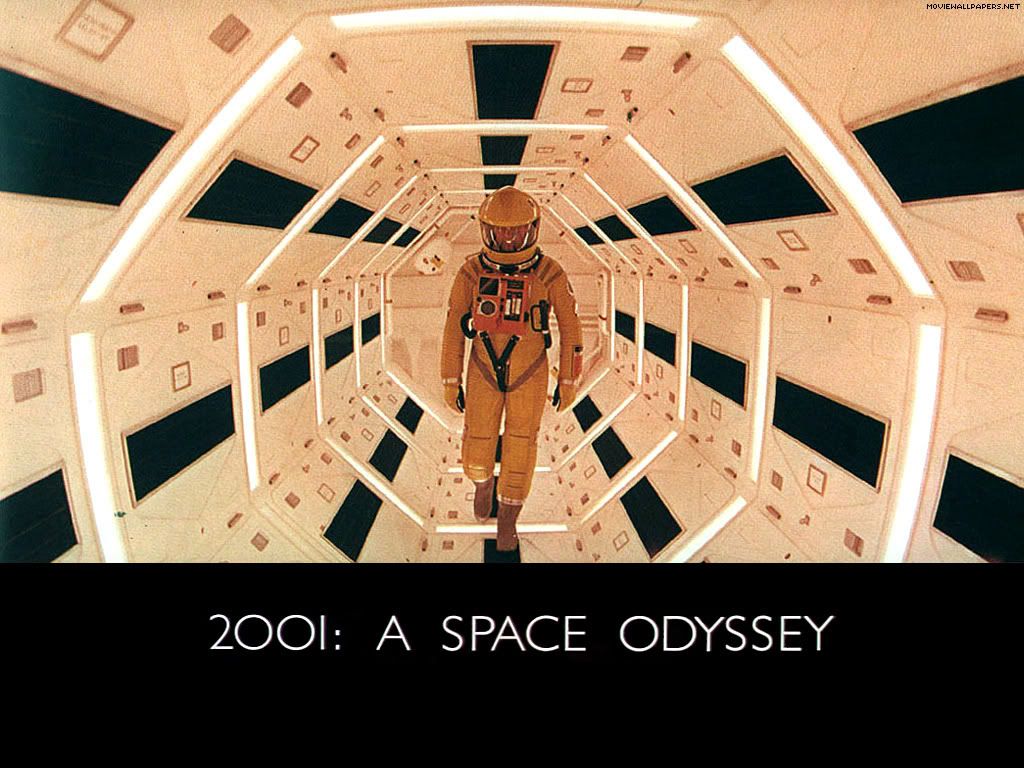
2001: A Space Odyssey is the greatest sci-fi film ever made. Period. Kubrik’s classic introduces an ahead-of-its-time exploration of human evolution, artificial intelligence, technology, extraterrestrial life and the place of humanity in the greater context of the universe. Although definitively esoteric in its content, individual elements could be lifted straight from a science textbook. The portrayal of an ape learning to use a bone as a tool and weapon. Missions to explore outer space, including depictions of alien life, spacecraft and computers that are so realistic, they were built based on consultations with NASA and Carl Sagan. The Heuristic ALgorithmic computer (HAL) that runs the ship’s operations is depicted as possessing as much, if not more intelligence than human beings, an incredibly prescient feat for a film made in 1968.
The Day The Earth Stood Still
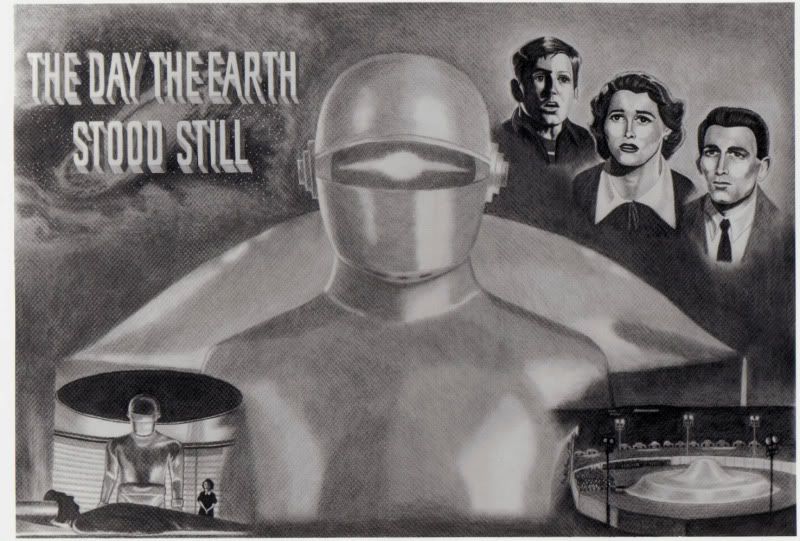
The Day the Earth Stood Still (we speak of the original, and not its insipid 2008 remake) is a seminal film in the development of the big-budget studio sci-fi epics. Given its age (the original came out in 1951), it still stands the test of time as a warning about the dangers of nuclear power. Well-made, sophisticated and not campy, TDTESS is one of the best cinematic emblems of the scientific anxieties and realities of the Cold War and nuclear era. It is usually a staple of Top Sci-Fi lists.
Jurassic Park
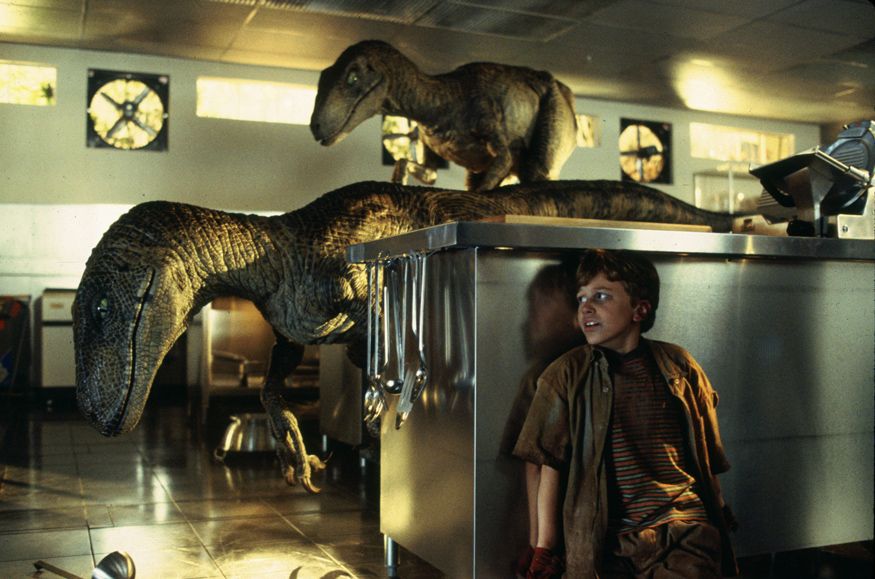
Jurassic Park, originally released in 1993, set one of the most important landmarks for modern science in film—the incorporation of DNA cloning as a significant plot element three full years BEFORE the birth of Dolly, the cloned sheep. Even more important than the fact that, although highly improbable, the science of Jurassic Park was plausible, is the idea that it was presented in an intelligent, casual and meaningful way, with the assumption (and expectation) that the audience would grasp the science well enough not to distract from the rest of the film. Furthermore, the basic plot of the film (and the book on which it was based) act as a cautionary tale about the dangers of unchecked scientific experimentation, and the havoc it can wreak when placed in the wrong hands. With the completion of the Human Genome Project in 2003, and the ability to sequence an organism’s genome in a day, bioethical questions about how personal genomics and the resurgent gene therapy are used are perfectly valid. Jurassic Park set a new standard for how modern science would be incorporated into movies.
Terminator 1 and Terminator 2

The Terminator?! Sounds campy, I know. We associate these adventure blockbuster films more with action, explosions and the rise of Arnold Schwarzenegger. Not game-changing science. Think again. The cyborg technology presented in these 1984/1991 action adventures was not only far ahead of its time scientifically, but smart, conceptual, and has really stood the test of time. Countless engineers and aspiring scientists must have been inspired by the artificially intelligent robots when the film first premiered. Today, with robotics technology enabling everything from roomba vacuum cleaners to automated science research, many engineers postulate that the day could even come that humanoid robots could someday fight our wars. Earlier this year, scientists at the German Aerospace Center even created the first ‘Terminator’-like super strong robot hand!
Apollo 13
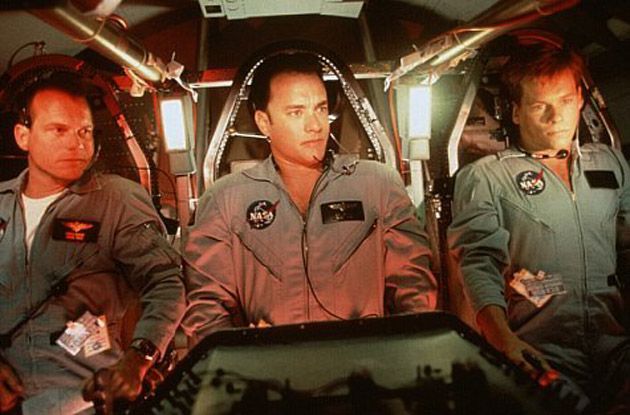
Space. The final frontier. At least in the heart of the movies. Far beyond the sci-fi genre, space travel, extraterrestrial life, and NASA missions remain a potent fascination in the cinematic world. For its feat as one of the most factually-correct space travel films ever made, with pinpoint portrayal of a monumentally significant event in the history of American science and technology, Apollo 13 enthusiastically lands on our list. Ron Howard’s almost-obsessive dedication to accuracy in detail included zero gravity flights for the actors (in addition to attending US Space Camp in Huntsville, AL), studying the mission control tapes, and an exact redesign of the layout of the Apollo spacecraft controls. Not only does the story inspire the spirit of adventure and innovation, it is 100% true.
The Andromeda Strain

For a film made in 1971, The Andromeda Strain (based on Michael Crichton’s novel by the same name) is a remarkably modern and prescient movie that has had a lot of staying power. The first really significant bio thriller film made, Andromeda’s killer viruses, transmissibility, and global infections have become de rigeur in our modern world. In the film, a team of scientists investigate a deadly organism of extraterrestrial origin that causes rapid, deadly blood clotting—perhaps an unintentional foreboding of Ebola and other hemorrhagic viruses. While the idea of a terrifying pandemic or biological emergency has certainly been replicated in many films such as Outbreak and 28 Days Later, no film has done a better job of capturing not just the sheer terror of an unknown outbreak, but the science behind containment, including government organization, the team of scientists working in a Biosafety Level-4 laboratory, and the fact that the story doesn’t overshadow the focus on the research and lab work. (Incidentally, as far-fetched as Crichton’s plot seemed to be at the time, recent research has shown that Earthly microbes traveling with US astronauts gained strength and virulence in space!)
Moon

One of the most recent films to crack our Top 10 list, 2009’s debut gem from sci-fi director Duncan Jones failed to amass an audience commensurate to its brilliance and modern scientific relevance. A sweeping, gorgeous epic in the shadow of (and certainly inspirited by) 2001: A Space Odyssey, Moon (ScriptPhD.com review) tells the story of Astronaut Sam Bell (Sam Rockwell), who is at the tail-end of a three-year solo stint on the Moon, mining for Helium-3 resources to send back to an energy-depleted Earth. As the sole employee of his lunar station, Bell works alongside an intelligent computer named GERTY (Hal’s third generation cousin), but on the heels of his return to Earth, uncovers an insidious plot by the company he works for to keep him there forever. There are so many scientific and technology themes that made this an obvious choice for our list. Moon exploration and human colonization has been a hot topic for at least the last 15 years, with a recent discovery that the Moon may have as much water as the Earth sure to fuel possible NASA exploration and additional Moon missions. The ethical morass of a greedy company with technology capabilities cloning an employee is not only done brilliantly, but evokes a realistic, chilling possibility in our evolving scientific landscape. Finally, Sam’s relationship with GERTY (voiced by Kevin Spacey), who ultimately transcends his robotic limitations to exercise free will in helping Sam escape the pod, is especially poignant as technology becomes a more intimate part of human life and literally changes our neurological makeup.
~*ScriptPhD*~
*****************
ScriptPhD.com covers science and technology in entertainment, media and advertising. Hire our consulting company for creative content development.
Subscribe to free email notifications of new posts on our home page.
]]>
